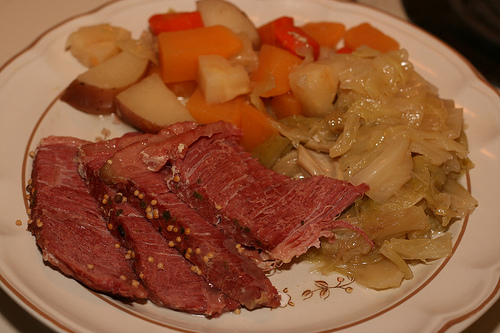What It Is:
- “Corned” refers to any meat that is cured or pickled in salty brine.
- Corned beef is a prominent ingredient in Jewish and Caribbean cuisine too.
- Corning became an especially important method of preservation from the 1680s to the 1800s as ships departed Ireland to explore Britain, continental Europe, Newfoundland and the West Indies.
- Most corned beef you buy is tender wet-cured corned beef made from brisket or round steak, but you can also purchase firmer dry-cured corned beef with granular salt or crumbly, oily canned minced salted meat.

History:
- It’s a popular misconception that the history of corned beef and cabbage traces back to Ireland. In fact, this dish was a New World creation of Irish immigrants.
- Canned corned beef is called bully beef in the UK and bœuf bouilli in France.
- In Ireland, corned beef and cabbage is considered “tourist food.”
- Boiled bacon and cabbage is a more traditional Old World Irish dish.
- The mention of corned beef first appeared in a 12th century poem “Vision of MacConglinne,” where it was described as a delicacy fit for a king. The poem goes, “He called for juicy old bacon, and tender corned-beef, and full-fleshed wether, and honey in the comb, and English salt on a beautiful polished dish of white silver, along with four perfectly straight white hazel spits to support the joints.”
- President Grover Cleveland once noted the smell of corned beef and cabbage emanating from the servants’ quarters of the White House and asked if he could trade his dinner with them. Afterwards, he remarked that it was the best dinner he’d had in months!
Cooking Tips:
- Choose the whole brisket from your local butcher for the best quality beef.
- Remember, the flavor is in the fat so look for a nice marbling.
- When looking for the right size, imagine that it will shrink 25 to 40 percent in size.
- Corned beef should be loaded with flavor and melt in your mouth, so slow-cooking it in a dutch oven or turkey roaster is your best bet.
- If your brisket is pre-brined, be sure to rinse it first and sprinkle seasoning over the beef, along with chunks of fresh garlic wedged into the beef before cooking.
- Corned beef spices include: salt peter, sugar, garlic, paprika, pickling spices, salt
- Simmer in a bath of seasoned simmering water or add two cups of beer for flavor.
- Corned beef is usually cooked at 325 degrees for 1 hour per pound or until the core temperature is 165 degrees. You can also use a cooking bag to trap the juices in. Beef should be fall-apart tender if touched with a fork but not mushy.
- When the meat’s done, get it out of the liquid immediately to prevent overcooking.
- Plunge the meat into ice water if you want to serve it on a chilled corned beef sandwich.
- If you’re carving it for a roast, slice across the grain pattern from the flat part to the point.
How To Serve It:
- Leftovers can be served with hash and eggs for breakfast or as a Reuben for lunch.
- The Reuben sandwich is made of corned beef, Swiss cheese, sauerkraut and Thousand Island dressing on rye bread.
- Smoked corned beef blended with a spice mix makes pastrami.
- New Englanders boil corned beef, cabbage, carrots, turnips and potatoes.
Nutrition:
- 5 ounces of corned beef and 1 cup of cabbage = 15 grams of fat and 340 calories.
- One serving provides 10 grams of carbohydrates and 19 grams of protein.
- Each serving has 80 percent of your daily value of Vitamin A, which gives you antioxidant benefits and promotes eye health.
- There is also 40 percent of your necessary Vitamin C, which helps you make collagen and heal wounds quicker.
- This dish is a good source of iron, which helps with red blood cell creation.
- Eight percent of your daily calcium is in this dish.
- There is bad news too: Each serving contains 5 grams of saturated fat and 1 gram of trans fat, which is not good for heart health.
- Also, one serving contains 1,110 mg of sodium – almost the entire daily limit.
Hint: Try this corned beef and cabbage recipe from Epicurious
 |
| Article: Jennn Fusion
Twitter: @jennnfusion |

